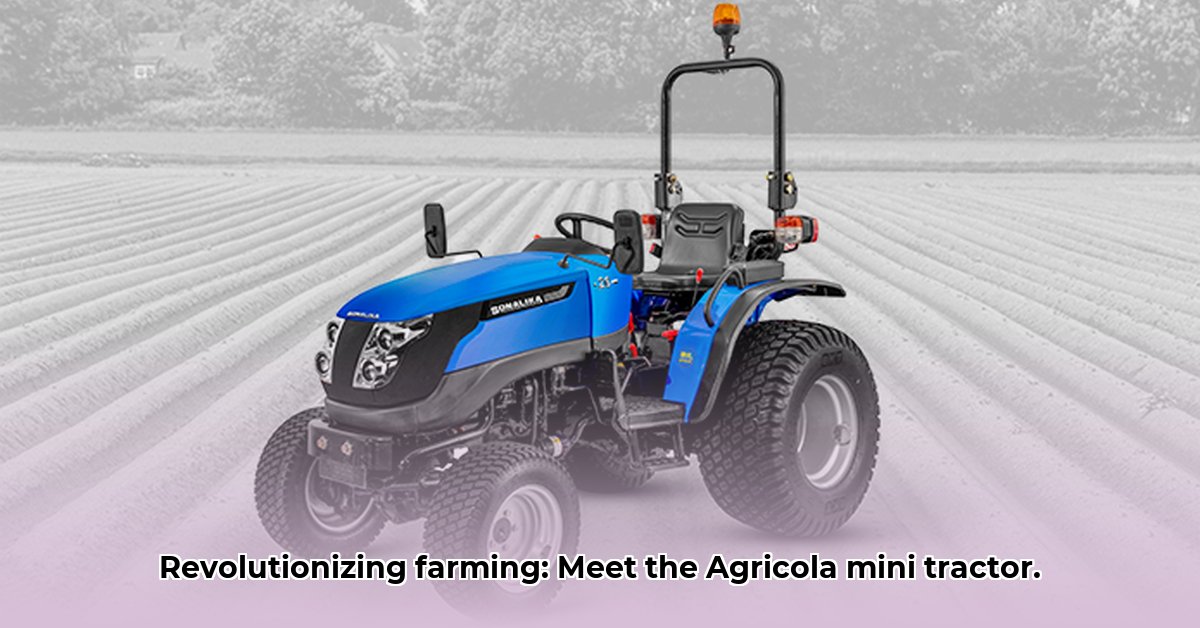
Mini Tractor Agricola: Revolutionizing Sustainable Farming
Mini tractors are transforming small-scale farming, offering increased productivity and sustainability. Their compact size and maneuverability allow for efficient work in tight spaces, unlike larger tractors that can compact soil and damage crops. This efficiency translates to higher yields and healthier soil – a win-win for farmers and the environment. But how do you choose the right mini tractor for your farm? For more information on mini tractor options, check out this helpful resource: Mini Tractor Guide.
The Small Farm, Big Impact: Why Mini Tractors Matter
Small farms are crucial to our food systems. However, traditional farming methods are often labor-intensive and environmentally taxing. Mini tractors provide a solution, especially for smaller landholdings. Their maneuverability allows for efficient work in confined spaces, unlike larger tractors, leading to higher yields and healthier soil. Aren't improved efficiency and environmental benefits a compelling combination for sustainable farming?
Mini Tractor Agricola: Precision Power on a Small Scale
Modern mini tractors, coupled with precision farming technologies, offer pinpoint accuracy in planting, fertilizing, and harvesting. GPS-guided systems minimize resource waste by reducing overlaps, improving efficiency, and lessening the environmental footprint. This precision farming approach not only boosts yields but also minimizes waste, aligning perfectly with sustainable agricultural goals.
Choosing the Right Mini Tractor: A Practical Guide
Selecting the right mini tractor involves careful consideration:
Assess Your Needs: List all tasks the tractor will perform. Will you need attachments like tillers or planters? Matching the tractor to your needs maximizes its usefulness and your return on investment.
Engine Power: Engine power dictates the tractor's capabilities. Heavier workloads require more powerful engines. Consider the typical tasks and field size when choosing engine power.
Size and Maneuverability: Size and turning radius are crucial, especially for smaller plots or areas with obstacles. Smaller tractors excel in confined spaces; larger ones are better for open areas.
Maintenance: Consider parts accessibility and maintenance costs. A difficult-to-repair tractor becomes a liability. Factor in regular maintenance and local repair services.
Budget: Include fuel, maintenance, and potential labor costs in your budget. A realistic budget prevents unexpected financial strains.
Sustainable Farming with Your Mini Tractor Agricola
Integrating mini tractors requires a focus on sustainable practices:
Fuel Efficiency: Plan routes carefully and operate the tractor efficiently to minimize fuel consumption. Smooth movements and well-planned routes translate to fuel savings.
Soil Health: Avoid excessive compaction by managing tire pressure and using appropriate techniques. Healthy soil is crucial for long-term productivity, and mini tractors, when used correctly, can help maintain it.
Precision Farming: Embrace precision farming technologies to optimize resource use. This targeted approach minimizes water, fertilizer, and pesticide usage, reducing environmental impact and boosting yields.
Crop Rotation: Rotating crops maintains soil health and reduces pest and disease buildup. This enhances long-term productivity and minimizes the need for chemical interventions.
Water Conservation: Implement efficient irrigation, such as drip irrigation, to minimize water waste. Water conservation is critical for environmentally sustainable farming.
Investing in Your Future: The Long-Term Perspective
The initial investment in a mini tractor may seem significant, but the long-term benefits – reduced labor costs, increased yields, and environmentally responsible practices – contribute to profitability and sustainability. Consider it an investment in your farm's future and the planet's well-being.
Challenges and Opportunities: Looking Ahead
Challenges remain: access to financing, skilled operators, and supportive infrastructure. However, the potential to increase sustainability and improve yields is significant. Overcoming these challenges will unlock the full potential of mini tractors, revolutionizing small-scale agriculture. The future is promising, requiring innovative solutions and embracing new technologies.
How to Compare Mini Tractor Long-Term Cost Effectiveness Across Different Farming Contexts
Key Takeaways:
- Mini-tractors are ideal for smaller farms (under 10 acres), offering fuel efficiency and lower maintenance.
- Larger tractors excel on larger farms (10+ acres), handling demanding tasks efficiently.
- Comparing long-term cost-effectiveness involves evaluating initial investment versus long-term productivity gains.
- Sustainable practices, like no-till farming, further influence cost-effectiveness.
- Careful consideration of farm size, budget, crop type, and long-term goals is crucial.
Sizing Up Your Needs: Mini Tractor or Bigger Machine?
Choosing the right tractor depends on your farm's size and needs. Mini-tractors (15-35 HP) are suitable for smaller farms (under 10 acres), offering fuel efficiency and lower costs. Larger farms require the power and capacity of larger tractors.
The Numbers Game: Understanding Long-Term Costs
Comparing long-term cost-effectiveness requires a detailed analysis:
- Initial Purchase Price: Mini-tractors have a lower starting price.
- Fuel Consumption: Smaller engines are more fuel-efficient.
- Maintenance and Repair: Simpler designs often lead to lower maintenance.
- Operating Costs: Include labor, fuel, and parts.
- Resale Value: Consider the tractor's future worth.
Beyond the Price Tag: The Bigger Picture
Productivity and environmental impact are also key factors. A larger tractor may complete work faster, leading to higher yields. Mini-tractors often cause less soil compaction, contributing to environmental sustainability and long-term savings.
Making the Right Choice: A Step-by-Step Guide
- Assess Your Farm: Consider acreage, crops, and terrain.
- Define Your Budget: Determine your spending capacity and explore financing options.
- Research Tractor Models: Compare specifications, features, fuel efficiency, and maintenance schedules. Research resale values.
- Calculate Total Cost of Ownership: Factor in all costs over the tractor's lifespan.
- Consider Sustainability: Choose a tractor and farming practices that minimize environmental impact.
- Consult with Experts: Seek advice from experienced farmers and agricultural machinery dealers.
Pros and Cons of Mini Tractors
| Pros | Cons |
|---|---|
| Lower initial purchase price | Lower horsepower, limited capabilities for large-scale operations |
| Reduced fuel consumption | Smaller working capacity |
| Easier maneuverability in tight spaces | May require more passes to complete the same tasks |
| Lower maintenance and repair costs | Limited attachment options |
| Better suited for sustainable practices | Slower work pace compared to larger tractors |